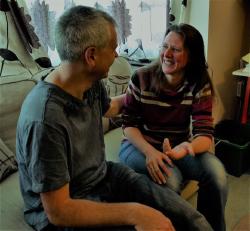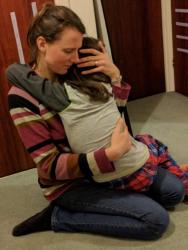What are the Hand in Hand Parenting tools?
What is Hand in Hand Parenting?
Hand in Hand Parenting is, at its simplest, a parenting approach which focuses on connection between family members (or between adults and children in any situation). But it’s so much more than that! When I first read an article on the Hand in Hand Parenting website, something about it really struck a chord with me. As a parent, it felt so supportive of me exactly where I was at on my journey. And the descriptions and explanations of the struggles of parenting felt so real to me - I felt like the author must surely have met me and my kids! And since that time, the approach has had an amazing impact not just on my parenting, but on my life in general.
Hand in Hand Parenting was founded by Patty Wipfler, based on her own experience of being a parent, as well as of working in education and of supporting parents/carers. The work is informed by the latest research into parenting, adult-child connections, neuroscience and trauma. The approach understands that we are all at different places on our journey, and that we all need support and guidance to do the best we can as parents/carers - and provides us with practical tools to help us to make shifts in our lives.
What are the Hand in Hand Parenting tools?
There are 5 Hand in Hand Parenting practical tools (I speak about them all, briefly, in this video) - they are mostly aimed at targeting various interactions between parents/carers and children, but one of the tools is specifically a parent-to-parent (or adult-to-adult) support. Let’s start with an overview of that one.
Listening Partnerships

Listening Partnerships are where we team up with another adult, and we exchange ‘Listening Time’. This means that one adult gets a timed turn to speak, whilst the other adult listens, and then you switch over, so that you each have a turn in both the speaker and listener roles.
Because a HUGE amount of the peaceful parenting journey is about exploring our own reactions in our parenting, being able to express ourselves in the security of a Listening Partnership is an absolutely invaluable chance to work through what’s hard for us, shed some of the emotions that cloud our thinking, and repattern our brains so that over time we are able to respond to our children more and more in the peaceful, respectful ways we want to be using.
When we’re in the role of the listener, we can feel a bit redundant at first - but in fact listening is hugely powerful. Just holding space for someone else to talk about, and (crucially) to feel what’s hard, without interrupting, offering advice or trying to fix anything, gives so much power back to the person speaking. Once they’ve had a chance to explore their own history, and to feel what they need to feel in the safe environment of the Listening Partnership, they can clear some of the long-held emotions that might be clouding their thinking, and gain clarity and insight into areas where they were previously feeling stuck. When we start to get free of past experiences that are keeping us repeating unhelpful patterns, we can take action in our lives that is much more what we want it to be - and it doesn’t just help our parenting!
This tool is probably one of the hardest ones a) to find the courage to reach out and begin, and b) to really grasp just how helpful it is until you’ve given it a go! But it really is worth looking into a bit further, and giving it a try - you don’t have to talk about all your deepest, darkest fears and experiences at first, you can start small, but it’s really worth just starting! You can find more information about some of the most common questions asked about Listening Partnerships here, as well as finding links to more resources if you are called to delve further into this amazing tool. And if you want to go a bit deeper, I highly recommend the Hand in Hand Parenting self-study course, Building a Listening Partnership to dig further into how to get the most from your Listening Time.
Now let’s move on to the parent/adult-child tools.
Special Time
Special Time is a dedicated, timed period of time, in which one adult and one child play together uninterrupted. As the adult, we focus on following the child’s lead, enjoying our time with them, and giving them our full attention. The child chooses the activity, and during Special Time we avoid teaching, steering the play, or correcting our child.
Special Time is absolutely WONDERFUL for building connection with our children, and for giving our children a chance to raise and work through anything that might be bothering them or puzzling them, in a free play situation.
To find out more about how to do Special Time (and what makes it different from how we might often play with children), have a read of this article.
Staylistening

Our children will all have big feelings at times in their lives - and being with those big feelings when they come up is part and parcel of our role as parent/carer! We use the tool of Staylistening to create the space our children need to express their feelings, so that they can ‘clear them out’ and move on from them.
There are some really helpful things we can do when Staylistening - like staying calm and warm, not trying to distract our children from their feelings, and showing by our demeanour that all feelings are welcome, and that our children will get through it when things feel hard. But this isn’t easy for many of us - and our own big feelings might come up when we’re trying to Staylisten! This is something that is SO helpful to take to our Listening Partnerships, so that we don’t get sucked into the situation and end up joining our child in their feelings - at least, not as often (we are human after all!).
Of course, there’s so much more to Staylistening than just sitting and listening! Here’s more information about the ‘how’ of Staylistening, as well as links to more articles and resources. You can also get a free download here, to help you with keeping your own calm, even when everything around you is kicking off!
Playlistening
Children tend to spend a lot of time in life in situations where they may not have much say or control over things (although, this is always worth examining - as some of the assumptions we might make about what children can or should do, aren’t quite as solid as we might think. Another place where Listening Partnerships can help!!). Playlistening gives our children a chance to guide and control the play and the laughter, and leads to opportunities to laugh off some lighter fears and feelings, to feel powerful (in a good way!), and to build connection.
It’s not necessarily as easy as it sounds - taking a step back and allowing our children to take the lead, or to ‘win’, as well as taking the less powerful, playing-the-fool role, can bring up some big feelings for us as adults! Working through our own feelings around this, by reflecting on our own experiences of adults’ playfulness when we were growing up, and by finding ways to get more comfortable with trying out this sort of playfulness, can really help. You can probably guess what I’m going to say now, can’t you?! Listening Partnerships are a great place to work through these issues!!
To find out more, have a read of this article that I wrote and see if it guides your thinking and learning around using this tool. You can also get a free download here, to support you with being more playful!
Setting Loving Limits
People often think that as peaceful parents, we don’t have any boundaries - that we just let our children do whatever they want, whenever they want - but that couldn’t be further from the truth! In fact, we tend to have fairly high expectations of our children; although we may well have fewer out-and-out ‘rules’ about behaviour than in mainstream families, we expect our children to behave in ways that don’t hurt others, themselves, or property. And we accept that at times, when they’re feeling frustrated, upset, or angry, we might have to help them uphold these boundaries - rather than just stating what we feel needs to happen and letting them get on with it (and probably fail).
The big difference is, that when we do have to set limits in some way, we aim to do it with warmth (and a simple explanation where needed/possible) - e.g. ‘Oh sweetheart, we can’t go to the park right now - we have to wait in for a delivery’. We avoid harsh limits (e.g. ‘Stop that!’), and power-over language (like ‘Because I said so’ or ‘Because I’m the adult’). And, crucially, we allow any feelings the child might have to be expressed - so if we do have to say no to something, and the child is upset about it, they have every right to express that upset (and then we’re back to Staylistening here!).
Guess what? This also isn’t easy!! Most of us will have grown up with limits being set harshly, arbitrarily and/or without explanation. So we’re learning a whole new skill here when it comes to intentional, warm, accepting-feelings limit setting. Sigh. You guessed it - Listening Partnerships for the win again!!
This article answers questions and gives more detail about how and why we set limits in the way we do in the HiH approach.
So why are we doing all this?!!
Well, we have some practical tools here then, to help us on our peaceful parenting journey - but wouldn’t it just be easier to follow the mainstream path, and do what our own upbringing has taught us? Well yes, yes it probably would!
But in peaceful parenting, we are really looking at the long game. It’s not the easy path, and goodness knows it won’t always (ever?!!) go smoothly - because it’s a constant learning curve of understanding ourselves better, so that we can learn to do things in the ways we want to do them.
But that’s why it’s important - we know that peaceful parenting feels like the right path to us. And actually, if we look into the latest science around how to raise our kids to be kind, confident, resilient… This path of putting connection first is where it’s at. And if we hold that strong connection with our kids as one of our core values - it makes all the hard work worth it.
Feeling a bit wobbly in your parenting - or life in general? You can get our FREE Core Values teaching, reflection and planning download here.
To find out more about the Hand in Hand Parenting approach, you can:
- Read the book
- Visit the website
- Sign up to a Starter Class course
To connect with the Journeys in Parenting community, where we practice and tweak and learn from this approach, you can:
- Join our amazing community group
- Sign up to receive our beautiful newsletter
- Follow us on Instagram
Emilie Leeks
AuthorEmilie is a heart-centred life mentor and space holder, supporting those on a healing path. This is not an easy journey, and often we can find ourselves losing our way. Emilie's work meets you where you're at, with beautiful, accepting support and connection, and weaves that support with practices and explorations in self-compassion, body connection, and a return to a deep trust in ourselves. Note: all blog post content which refers to them, has been read and agreed to by Emilie's children.
View All Posts